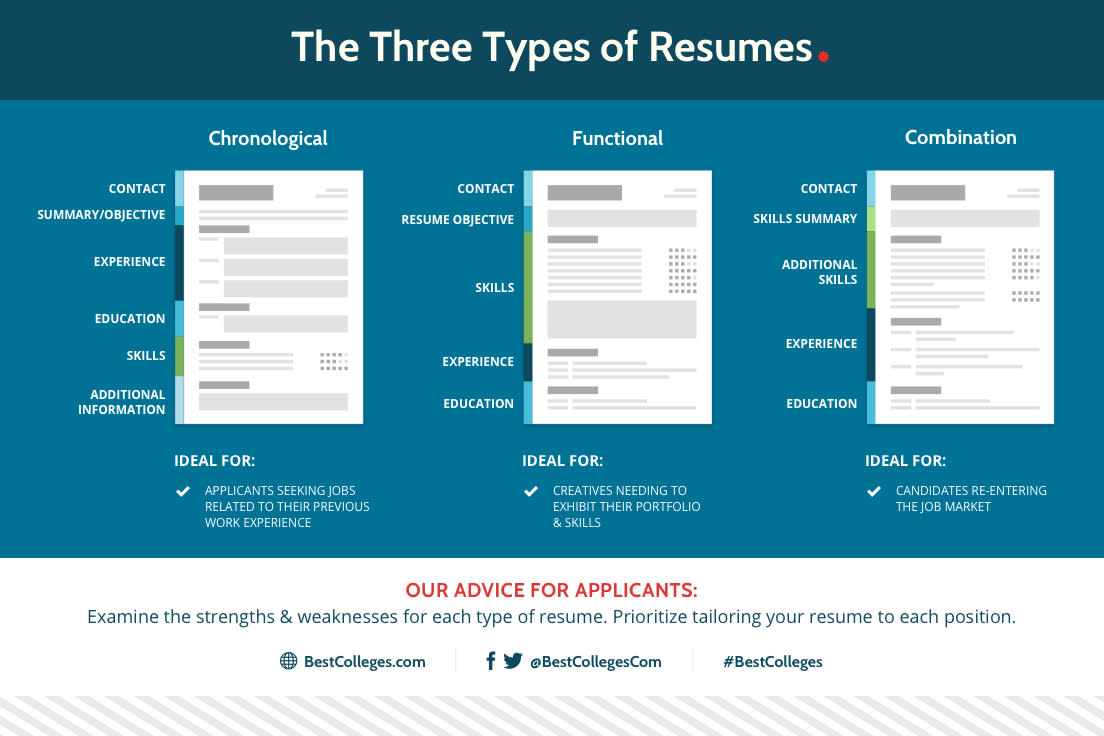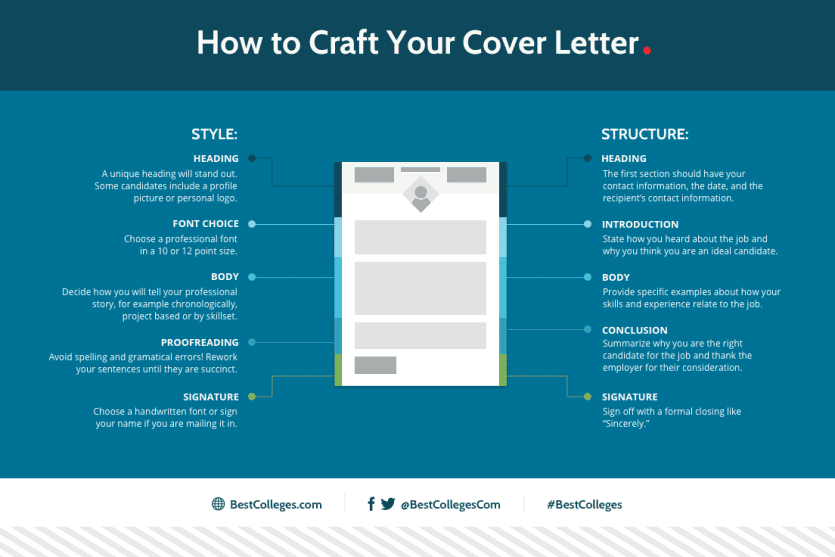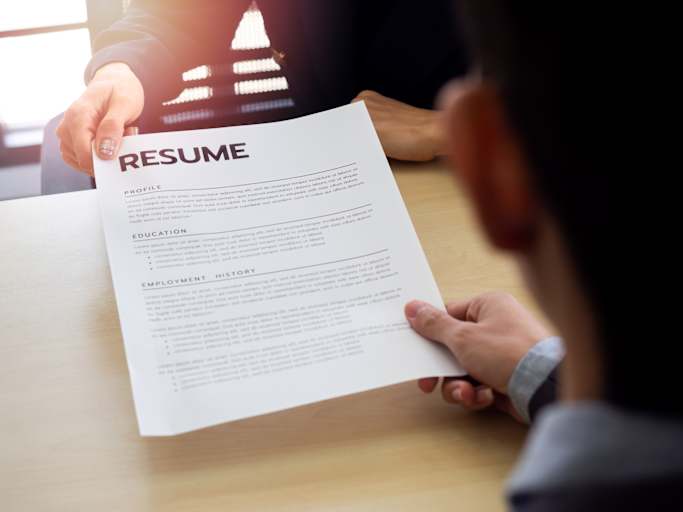The Student’s Guide to Resumes and Cover Letters
- Many jobs in the U.S. require applicants to submit both a resume and cover letter.
- Most resumes follow a chronological format, listing items from most recent to oldest.
- Cover letters should include a greeting and explain why you’re a good fit for the role.
- Looking at sample cover letters and resumes can help you craft an engaging document.
Getting a job can be challenging for even the most experienced professionals. Much of this difficulty stems from the number of applications companies receive for a single position. According to Glassdoor, the average corporate job opening attracts at least 250 candidates.
To stand out, candidates must have an impressive resume and cover letter. The best resumes and cover letters succinctly summarize your qualifications, relevant experiences, goals, and accomplishments.
Recruiters spend an average of just 7.4 seconds scanning a resume before they make a decision on whether to move that candidate forward. A well-constructed, easy-to-read resume and an engaging cover letter are key to securing an interview — and, hopefully, a job.
In this guide, we’ll cover what resumes and cover letters are, how to format them, and helpful tips to keep in mind as you write your resume and cover letter.
Cover Letter vs. Resume: What’s the Difference?
Cover letters and resumes are the main components of job applications in the U.S. But what exactly is the difference between a cover letter and resume?
A resume is an overview of your skills, education, work history, and relevant achievements. Usually a page long, this document comprises a bulleted list of accomplishments, which summarize your experiences that are most relevant to the position you’re applying for.
In contrast, a cover letter is a more personable letter that explains who you are, why you’re applying for a specific position, and what makes you a strong candidate for that role. This document also gives you the chance to add a more personal touch and demonstrate your writing ability.
Many jobs require applicants to send a cover letter along with a resume.
How to Format a Resume in 3 Ways
Formatting a resume can take time. There are three main types of resume formats:
- Chronological
- Functional
- Combination
Below, we look at the pros and cons of each resume formatting type.
As always, job-seekers should take the time to tailor their resumes to each position they apply to. Remember that employers value personalized applications because they reflect a strong worth ethic, attention to detail, and creativity.

1. Chronological
The most popular resume format, the chronological (or reverse chronological) resume highlights professional experiences starting with the most recent before progressing to the oldest. This type of resume best suits job-seekers with relevant, uninterrupted work histories.
Each position should include 3-5 bullet points describing your primary duties and biggest accomplishments. Be sure to start each bullet with an action verb and use quantifiable achievements.
2. Functional
The functional resume emphasizes skills over experience, making it an ideal format for recent college grads, career changers, and professionals with gaps in their work history.
With this format, the resume begins with a personal statement that summarizes the relevant job skills that follow. Although it’s good to include valuable soft skills, you should also mention any in-demand hard skills you have, like mastery of computer applications or data analytical software.
After, you’ll provide a concise list of relevant work experiences, followed by a snapshot of your education.
3. Combination
As its name suggests, this resume format combines work history and relevant skills to create a flexible document suitable for professionals with extensive experience in their industry.
Like the functional resume, the combination resume begins with a detailed skills section before introducing your employment history in reverse chronological order. Jobs listed should provide evidence of your skills in action, bolstered by quantifiable successes.
Job-seekers often find the combination resume the most difficult to create since it contains so many elements. To make the process easier, consider including only skills and positions that directly relate to the job you’re applying for.
How to Make a Cover Letter for a Resume
Cover letters use a relatively strict format. This uniformity allows recruiters and hiring managers to quickly identify key elements when vetting applicants.
Below, we go over the main sections to include in a cover letter for a job.

 Heading
Heading
The heading should contain contact info for both you and the company to which you’re applying. Be sure to separate these elements clearly by presenting each item on a new line.
Here’s what to include:
- Your Contact Information: This includes your full name, email address, phone number, and home address (alternatively, you can just include your city and state). You may also provide links to your professional website, online portfolio, or LinkedIn profile. Make sure you use a professional email address, ideally one that includes both your first and last name (such as jane.doe@email.com).
- Date: This is the date you submit your job application. In general, the date should be on its own line after your contact information.
- Recipient’s Contact Information: Traditionally, this consists of the company’s name, address, phone number, and email address.
 Greeting
Greeting
The introduction contains a standard greeting like “Dear” followed by the full name of the hiring manager or department head and ends with either a comma or colon. It’s best to avoid using gender-specific titles like Mr., Ms., and Mrs. Job-seekers can usually find the proper recipient’s name by searching the company’s website or contacting the front office.
 Introduction and Body
Introduction and Body
The cover letter gives you 2-3 paragraphs to detail your professional qualifications and set yourself apart from other applicants. As such, it’s important to include the most relevant, impressive details in a concise manner.
The first paragraph, or introduction, should focus on your intent to apply, specifically referencing the company and the position you’re seeking. The second and third paragraphs should summarize your most relevant skills, credentials, and work experience.
A good rule of thumb is to elaborate on major accomplishments and skills that you didn’t get the chance to discuss in depth on your resume.
 Conclusion
Conclusion
The conclusion paragraph is meant to link the company’s needs with your unique skill set. In essence, it should highlight the main reasons why you’re the best candidate for the position. This section should reflect your genuine enthusiasm for the role and willingness to discuss your qualifications in greater detail.
 Closing
Closing
Because a resume is a form of professional correspondence, be sure to sign off with a formal closing like “Sincerely,” “Regards,” or “Best,” followed by your full name.
4 Essential Resume and Cover Letter Tips
Many college students and recent grads know little about job hunting and what the process entails. Use the following resume and cover letter tips to improve your chances of impressing hiring managers and securing an interview.
1. Look at Sample Cover Letters and Resumes
Sample cover letters and resumes offer helpful starting points when crafting your own materials for a job. Popular job search sites like Indeed and Monster offer many resume and cover letter samples for a variety of fields.
College students and recent grads can also visit their school’s career center for examples of effective application materials and advice on how to write a resume or cover letter.
Another good idea is to ask people in your network — such as classmates, co-workers, recent grads, parents, friends, and relatives — if you can look at the resumes and cover letters that got them jobs.
2. Tailor Your Application Materials to Each Position
Companies want people who demonstrate a strong worth ethic and a passion for the industry in which they’re seeking employment — and this begins with uniquely tailored application materials.
While resume and cover letter templates provide a good starting point, job-seekers should tailor each document to the positions they apply for. Typically, this means tweaking your skills and even using keywords from the job description in both your resume and cover letter.
You should spend some time researching each company as well. Doing this can help you speak to that employer’s general philosophy, workplace culture, and organizational goals in your resume and cover letter.
3. Use Numbers to Quantify Your Achievements
Instead of simply telling a company about your accomplishments, try to bolster your credibility by quantifying your responsibilities and successes.
For example, say you were a regular contributor for your campus newspaper. On your resume, you could discuss how you wrote approximately two 500-word articles each week your junior year.
Here are some other ways you can use numbers on a resume or cover letter:
- Page performance on Google and other search engines
- Percentage increases or decreases for things like company costs and profits
- Number of readers, viewers, customers, shares on social media, etc.
- Dollar amounts for things like sales, company profits, etc.
4. Proofread
Hiring managers read tons of job applications, so even the slightest error in grammar or formatting can mean a quick end to your candidacy for a job. This is why it’s critical that you take the time to edit and proofread your resume and cover letter before you submit them.
Once you’ve drafted both documents, spend time checking for common issues such as incorrectly spelled names, inaccurate contact information, and missing information like your email address and greeting.
Remember that oftentimes even minor mistakes can make or break your application. It’s a good idea to have someone you trust, such as a career counselor or parent, look over your resume and cover letter.
Frequently Asked Questions About Resumes and Cover Letters
How can you write a cover letter or resume with no job experience?
Many college students have never held a full-time job — some not even a part-time job — when they graduate. Regardless, you can still craft an engaging resume and cover letter by focusing on activities such as volunteer experience, major school projects, honors and awards you’ve received, and relevant hobbies or skills you have, like other languages you speak.
You might also mention things like school clubs you participated in, sports you played, and what kinds of leadership positions you held (if any).
Do all job applications require a cover letter?
While many jobs in the U.S. require applicants to submit both a resume and cover letter, there may be cases in which you are not required to send a cover letter. Nevertheless, many agree that it’s best to submit a cover letter for every job, as this document gives you the opportunity to make a case for yourself and clarify why you believe you’re the best candidate.
Even if a hiring manager or recruiter doesn’t initially read your cover letter, it’s always good to make the document available to them should they need to refer to it for any questions or should they be on the fence about your candidacy.
Is there anything you should avoid in your resume and cover letter?
Like other professional documents, it’s best to avoid getting too personal in your resume and cover letter — there’s no need to discuss your family or anything not directly related to the job, your past work performance, and your professional goals.
Other things to avoid in a cover letter and resume include typos and grammar errors, wordiness (both documents should generally be capped at one page), and uncomfortable topics like why you were fired from your previous job.
In your cover letter specifically, take care to avoid focusing too much on yourself — you want to explain why the company and role are good fits for you as well as what you can offer them.


